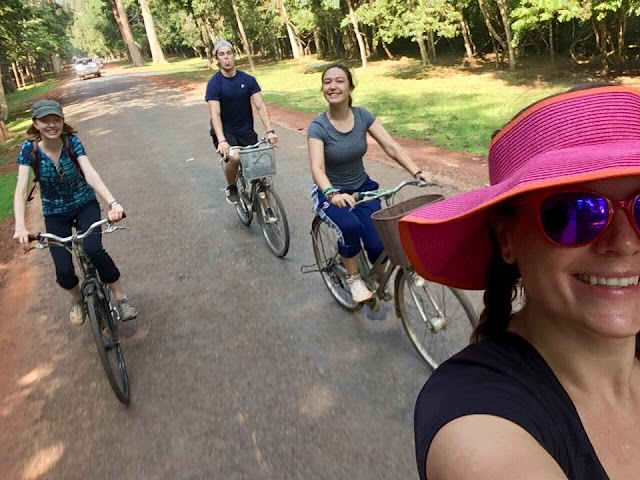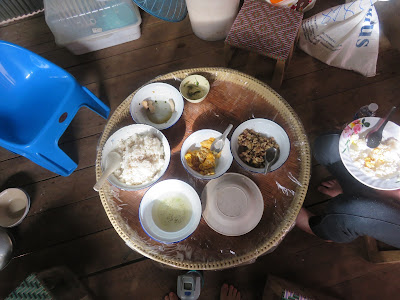Hi all! So as many of you know, I am home now from my adventure :) But the adventure hasn't ended. I'm still growing and reflecting on this amazing experience I've had.... and one of the ways I'm doing that is through continuing my blog that I never finished.
So...let the adventure continue!
****P.S. We were all sharing photos on my trip, (and even my camera at one point), so not all of these pictures are mine. I would like to credit my lovely friends and my program leader Jaci for many of the "people pictures" in this post!
**************************************************************************************************************************************************************************************************
October 23rd - 31st, 2017.
Cambodia.
So...let the adventure continue!
****P.S. We were all sharing photos on my trip, (and even my camera at one point), so not all of these pictures are mine. I would like to credit my lovely friends and my program leader Jaci for many of the "people pictures" in this post!
**************************************************************************************************************************************************************************************************
October 23rd - 31st, 2017.
Cambodia.
How can I even begin to explain Cambodia? From the moment we
started to descend in the airplane above Phnom Penh, I knew we were entering a
place wholly different from anywhere we’d been up until this point.
Unlike Bangkok, there were no high-rise buildings, and the
city was relatively small, stretched along the muddy brown Mekong River. There
was no urban sprawl either, it was quite clear where the city ended and the
wild, lonely swamp-land began.
We spent our first couple days in a hotel in the city center, which turned out to be a little more city-like than I had expected. Many of the buildings and hotels in the area sported neon lights that glowed with a vengeance all night long.
The streets bustled with plenty of modern
restaurants – many of them serving western food rather than Cambodian. And
there was a beautiful cobbled square with pigeons that one could have found
somewhere in Europe.
But there were also darker sides to the city. There were the
small children who accosted us at every restaurant and street corner, trying to
sell us bracelets out of baskets they hung around their necks.
There was the unsettling number of old, white, men everywhere
you turned, pointing to the prevalent business of sex tourism in Phnom Penh.
And then there was the Cambodian genocide. We spent an
entire day visiting the Killing Fields and the Tuol Sleng Genocide Museum,
learning, and hearing first-hand about the atrocities committed by the Khmer
Rouge towards the Cambodian people.
The two sides of the city, dark and light, were tangled up
in a web so complex it was impossible to separate them.
Madi, Anna and I on the riverboat.
So while we took a peaceful riverboat and
viewed the city skyline by sunset, I couldn’t stop thinking about the millions
of average citizens, who one day in 1975 were forced to flee from the city on
foot and were worked to death in camps in the rural parts of the country. The
Cambodian flag, which fluttered gently on the prow of the boat, made me think
of the bits of clothing that I stepped over in the killing fields. Bits of
clothing, and bits of bones—that are still surfacing after 40 years.
But when I walked through the Tuol Sleng prison, past cell
after cell, and the metal beds with the indents of the people who were tortured
in them, all I could think of was the fact that on the other side of these cold
brick walls, life today goes on.
The Tuol Sleng memorial prison
The blood on the walls spoke of unimaginable suffering…… but it also mirrored the red costumes that the dancers wore at Cambodian Living Arts, where today, young students are carrying on the traditions of Cambodian culture.
We visited Cambodian Living Arts on our last day in
Phnom Penh. Tucked away in a narrow, terraced office building off of a busy
street, it was like a quiet gem in the heart of a noisy and and conflicted
city. The organization was founded by a man named Arn Chorn-Pond, who, having
lived through the Khmer Rouge regime as a child, had witnessed first-hand the
systematic killing of nearly 90% of Cambodia’s artists. Arn wanted to pass on
the traditional music and dance of Cambodia to the nation’s youth, before they
were lost forever.
After watching a performance done by some of the young
artists at the organization, we got to learn a group dance.
On our 4th day after arriving in Cambodia, we
drove six hours north to Siem Reap. Once we got outside the city, it was amazing
how rural everything was. There were fields of water lilies…….palm
trees….houses on stilts. The houses were similar to those in Thailand, but
there was definitely a more foreign feel to things.
We made a pit-stop at a roadside market along the way, and
selected a couple particularly large spiders from the assortment of fried
creepy crawlies as snacks for the road. I used my status as “Vegetarian” as an
excuse for not eating any of those hairy legs. .
After we finally arrived in Siem Reap, and had dinner downtown, we decided to walk around.
Downtown Siem Reap was definitely the one place during our
trip where I felt most like a tourist. My friends and I were literally treated
like walking bags of money. If we so much as stopped to look in one of
the shops selling batik pants, silk scarfs, and souvenirs, we were immediately
accosted by at least one of the many shop employees.
This is how a typical encounter would go:
My friend and I walk into a shop.
Shop employee #1: “Lady, what you like to buy?”
Me: “Nothing. I’m just looking.” Walks further back into the shop, and pauses to look at a rack of skirts.
Shop employee # 2: “You looking for a skirt? These are very nice ones. How about this skirt? You buy this skirt."
Me: “Nothing. I’m just looking.” Walks further back into the shop, and pauses to look at a rack of skirts.
Shop employee # 2: “You looking for a skirt? These are very nice ones. How about this skirt? You buy this skirt."
Me: “No
thank you.” Walks quickly
away. Makes the mistake of fingering a magnet with the Cambodian
flag on it.
Shop employee #3: “You want souvenirs? Jewelry? Here lady – you buy this!”
Shop employee #3: “You want souvenirs? Jewelry? Here lady – you buy this!”
Me: “No thank you!” Ducks in-between a rack of dresses in an attempt to escape.
My friend: “Emily, where are you??!”
Shop employee # 27: “You pay me and I tell you where your friend is.”
Needless to say, we quickly lost our appetite for shopping, and
retreated back to our hotel empty handed.
After only the first night, I started to feel a little
disenchanted with Siem Reap. It was hard to explain, even to myself. But I was
saddened by how tourist-y it was, and I found myself yearning for a more
culturally enriching experience.
Angkor Wat, which we visited the next day, was definitely
more tourist-y than I had pictured also. But the temple complex was absolutely
amazing.
Angkor Wat is actually a whole complex of
different temples, which includes not only Angkor Wat proper (the largest and most iconic one), but also others such as Ta Prohm, the "giant tree-root" temple.
.....And once on bikes.
Jaci, Anna, Will, and I
The biking that we did around the temples was definitely the highlight of the week for me. It was hot, dusty, and exhilarating to navigate the weaving and chaotic traffic on the way to the temple. But once we were there, it was peaceful peddling around the temples through the majestically tall, silent trees.
As our week came to a close, I felt all mixed up inside
about Cambodia. Thinking about the Khmer
Rouge and the Cambodian genocide, I felt chilled, like there was a giant,
invisible shadow over the country. Cambodia
may have overcome its violent past, but it can never forget. And thinking
about how tourist-y Siem Reap was, with its western restaurants and massage
parlors, I felt saddened. I felt like Cambodia was wearing a mask…. losing a
part of its culture in the name of making profits off of western travelers. These
two aspects were very much a part of Cambodia’s identity. But I felt like
something was missing.
On our final night in Cambodia, I got a glimpse of that
missing piece. Our wonderful guide, Bun, took us to his house (which he has
turned into a homestay) for dinner.
Bun explaining about the history of Angkor Wat
It was on the outskirts of Siem Reap, but
was a world away from the shops and restaurants in downtown. Many of the
neighborhood children came over, and gave an informal singing and dance
performance on the porch. We mingled with the tourists who were staying there,
danced with the children, and joked around with Bun. It felt like a true
community.
As it got dark, I went up to the deck with Bun to interview him for
my media project. And as we sat there, I realized that what I had been missing
in Cambodia was the people, and the community. It was harder to find
this here, because we were visiting for such a short time, and weren’t staying
with host families. But this was the missing piece—the “real” Cambodia just
under the surface. It was the Cambodia of family, and schoolchildren. Of people—just people—just friends. And as we sat there, Bun called out across the
swamp in front of his house…. called out to say hello to some friends. They
were but small, dark shapes wading in the water, with bobbing lanterns. They
seemed to be fishermen. Despite the distance, they shouted hello in return.

















































